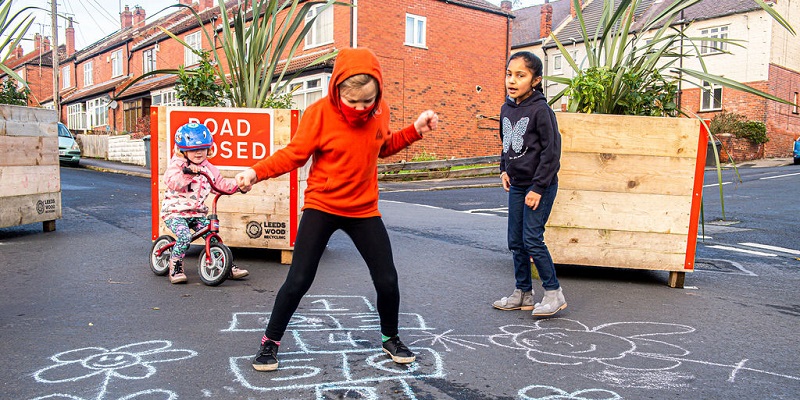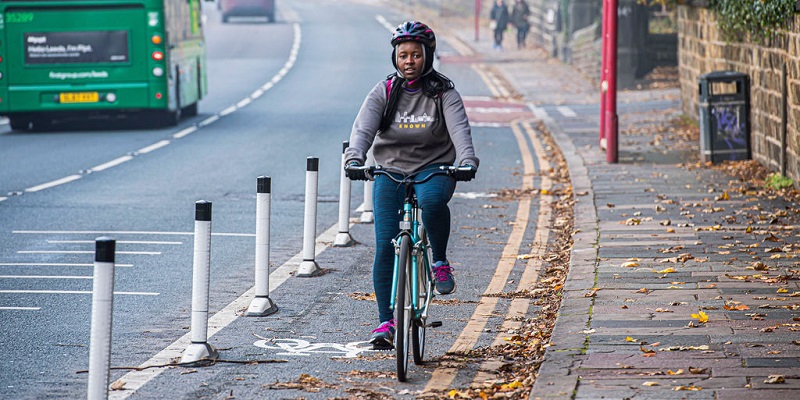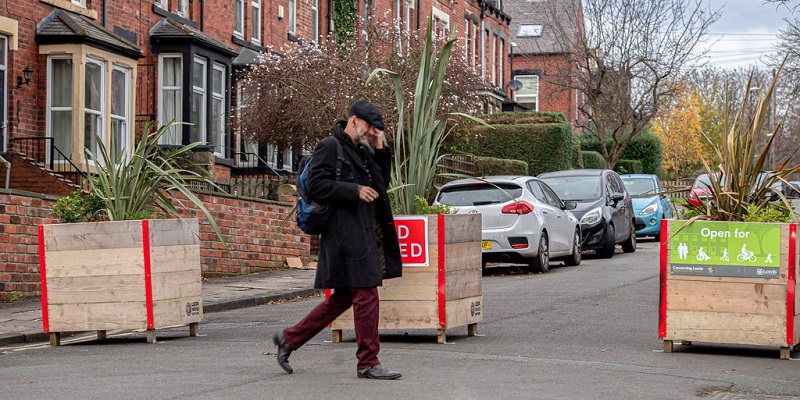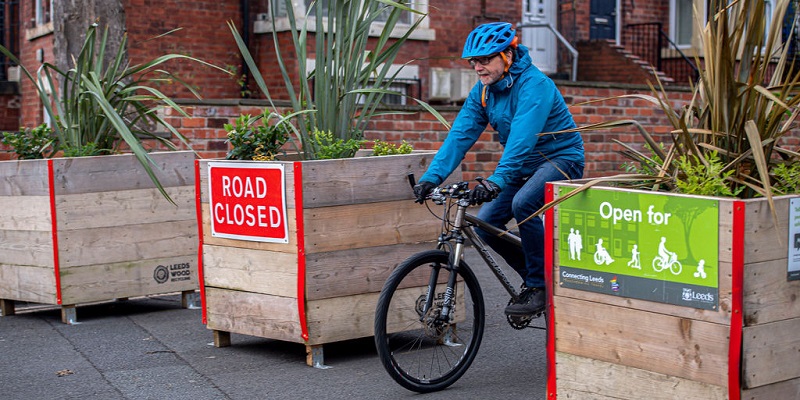What is an Active Travel Neighbourhood?

What is an Active Travel Neighbourhood?
The ambition
Consultation
Have your say!
Feedback so far
Implementation and review
Get involved in local travel decisions
What is an Active Travel Neighbourhood?
You may have noticed some changes around the Hyde Park area recently, with the addition of physical measures such as planters and altered road priority. These are part of an ‘Active Travel Neighbourhood’ (ATN) initiative – also known in some other areas as a ‘low traffic neighbourhood’ (LTN), or ‘mini-Holland’.
The Hyde Park scheme is one of three ATNs in Leeds, with trials also occurring in Chapeltown and Beeston. They seek to address some of the big issues that people identify relating to traffic and travel in their local areas, including:
- Reducing speeding
- Improving road safety
- Enabling children to be able to play out safely
- Addressing congested pavements (e.g. with parked vehicles) - creating space to make areas more accessible, for people as well as essential services
- Reducing pollution to improve air quality and local health outcomes
- Boosting confidence to undertake more active travel (e.g. walking, running and cycling) to local shops and amenities.
How did the Leeds ATNs come about?
The COVID-19 pandemic has changed how we live and travel, with reduced commuting levels in lockdown resulting in fewer cars on the roads and many of us travelling actively more often. Since May 2020, Leeds City Council has been undertaking public consultation via the Commonplace platform on a range of travel projects, encouraging residents to have their say and shape proposals for transport infrastructure plans in the city. According to the Council,
Over 4,500 resident responses and 24,000 contributions found that excessive levels of traffic and speeding were the key concerns identified locally; residents also wanted to see more space for walking and cycling as well as more greenery
Phase 1 of central government funding from the Department for Transport (DfT) - specifically ring-fenced for emergency active travel - was allocated to Leeds via the West Yorkshire Combined Authority (WYCA) in June 2020. This was to be spent within set timescales to deliver the trial ATN schemes as well as School streets initiatives and trial segregated cycle schemes – including along the A660 (Otley Road) - introduced in the city over the last few months.

The ambition
The Hyde Park Active Travel Neighbourhood supports the wider programme of initiatives underway as part of Leeds City Council’s response to COVID-19. This aims to help people take better travel choices as part of the ‘safe streets, save lives’ campaign supporting greener, healthier and safer neighbourhoods in the city. Furthermore, it addresses the council's Climate Emergency declared in March 2019, the resolution to make Leeds carbon neutral by 2030 and the vision of the new draft Connecting Leeds Transport Strategy (which is being consulted on until March 2021) for “Leeds to be a city where you do not need a car”.
This aligns with the University’s own commitment to Net Zero 2030 outlined by our Climate Principles, and specifically via Principle 6 in supporting the development of a sustainable transport system for the city region, thereby also helping to reduce the University’s indirect carbon footprint.
Consultation
The ATN concept is designed to be iterative in nature, trialling experimental measures on the ground during a pilot phase of between 6 – 18 months, during which residents are encouraged to feedback on their lived experience of the measures in place to inform changes made during the trial and longer-term infrastructure plans.
The COVID-19 pandemic has constrained opportunities for face-to-face public engagement that would typically be undertaken, and increased the reliance on the online Commonplace platform for feedback. Nonetheless, wider consultation has included:
- Letters delivered to residents and businesses on streets deemed part of the ATN advising of the changes and inviting comments
- Engaging with stakeholders such as the Emergency Services before and during the trial, with no adverse feedback raised from their operations and their response times.
-
Hard-to-reach groups contacted via organisations such as Leeds Involving People.
Have your say!
Making basic behaviour changes such as the way we travel – facilitated by infrastructure adjustments to support these - are necessary, otherwise we cannot tackle more difficult challenges that climate change presents. The Council is keen to learn lessons to inform next steps for the ATNs and wider future transport plans in the city.
If you live in or travel through the Hyde Park ATN and have comments or ideas on how local community engagement can be improved, you are encouraged to have your say in the ongoing consultation. You can find more detail on the Hyde Park ATN including the aims, key features and a map of the plans – and your opportunity to comment on the commonplace website.
If you have any questions or would like to provide comments directly to the Sustainability Service, you can email us at sustainability@leeds.ac.uk.

Feedback so far
As with any infrastructure change, it can take time for local areas to adjust and full benefits to be realised – initial frustrations can include sat-nav re-routing and being required to navigate different accessible routes rather than the established auto-pilot short-cuts we are used to taking. Experience from other more established ATNs such as Waltham Forest, NE London which featured in a recent webinar hosted by the Leeds Civic Trust, has indicated that sometimes initial increases in traffic is observed before reducing. It has been seen that they are effective in reducing congestion rather than pushing traffic elsewhere and often re-direct to larger routes better able to take the volume of traffic in the longer-term. Hence the need for the trial to also accommodate for seasonal fluctuations that would typically affect the likelihood of people making more journeys by foot or bike.
Experience of ATNs in Hyde Park and elsewhere in the city illustrates that after an initial settling-in period, adjustments can ultimately bring about positive impacts.
As Leeds resident living within the Chapeltown ATN, Robin Lovelace, Associate Professor of Transport Data Science at the Institute for Transport Studies (ITS) comments:
(My) road has been closed to through traffic. Nearly a month later and we are very happy, it's noticeably a quieter and more peaceful place to live. It is certainly safer, a minority of drivers used to treat our area as a racetrack and thankfully that has completely ended on our street and been greatly reduced on other streets in Chapeltown as far as I can tell. Some disgruntled drivers expressed frustration during the first few weeks but, on our street at least, residents seem to be overwhelmingly in favour of the scheme.
Adam O’Malley, University of Leeds student and founder of Green Streets for Hyde Park reflects:
The Hyde Park ATN has been great for the community, it’s been wonderful to see children playing in the street and our streets become quieter and less polluted. The community have adopted their planters, holding bulb planting events and decorating them for Christmas. Although there was some initial disruption as drivers got used to the changes, things have settled down and it’s much easier to get around by foot or by bike. I now cycle to the shops, and really appreciate the safer streets. The ATN tackles the growth of traffic on our streets caused by satellite navigation apps, and reduces our exposure to harmful air pollution and road danger. It would be great to see the reintroduction of the filter on Royal Park Road, as this is a really busy junction and is very hard to cross on foot.

Implementation and Review
The time-critical nature of the emergency funding has undeniably resulted in challenges in the design, planning, communications and engagement across the active travel pilots that the Council have implemented in challenging and constrained times due to the COVID-19 pandemic.
Leeds City Council are delivering the ATNs using an experimental traffic order which means they are trialling the road closures temporarily, and monitoring feedback gathered to inform future decisions. Before permanent closure to ‘through’ traffic, a statutory process would need to be followed which includes publication of notice and formal consultation.
Considering the challenges of ATNs, Morgan Campbell, Research Fellow at ITS notes that:
From the perspective of City Councils, one of the biggest challenges is situating timescales within the context of public communication and support. There is enormous pressure on Councils to spend the funding allocated to implement positive changes and ensure that there is community support for initiatives such as closing off roads to vehicle traffic and installing planters. Such community support takes time as communities need to feel informed and consulted upon. This isn’t necessarily unique to ATNs but more indicative of the challenges of how to go about sustainable transitions to new mobility futures in a way that speaks to the urgency and opportunities that arise as well as the pace at which public involvement and consultation must occur.
ITS have recently secured funding for a project to support Leeds City Council in the monitoring and evaluation of the ATN schemes in Leeds. Morgan explains
Our project addresses this challenge by learning from the process that is unfolding in Leeds in real time. We are working directly with the Council, analysing the qualitative and quantitative data being gathered by Council and third-party platforms and working on outreach strategies. Whilst our focus is Leeds, we aim to be informed by and informing of other cities in which this initiative is occurring.
Get involved in local travel decisions
There are several consultations currently open which provide an opportunity for you to have your say. These include:
- Hyde Park Active Travel Neighbourhood (ongoing)
- Chapeltown Active Travel Neighbourhood (ongoing)
- Beeston Active Travel Neighbourhood (ongoing)
- The draft Connecting Leeds Transport Strategy (closes March 26)
- Leeds Bradford Airport (LBA) Parkway Station proposals (closes 21 February)
If you have any questions or would like to provide comments directly to the Sustainability Service, you can email us at sustainability@leeds.ac.uk.
Keep up to date on the latest news
-
- Follow us on Twitter: @UoL_Sus
- Follow us on Instagram: @uol_sus
- Follow us on Facebook: @UoLSustainability
- Sign up to our Sustainability newsletter
United Nations Sustainable Development Goals
We use the United Nations Sustainable Development Goals (SDGs) as a framework to guide our activity. Our work on sustainable travel is linked to the following SDGs:
- Goal 3: Good health and well-being
- Goal 4: Quality education
- Goal 9: Industry, innovation and infrastructure
- Goal 11: Sustainable cities and communities
- Goal 13: Climate action
- Goal 17: Partnerships for the goals
Find out more about our impact on the SDGs.
